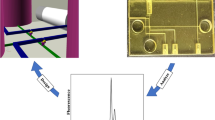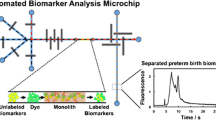Abstract
We have developed microfluidic devices with pressure-driven injection for electrophoretic analysis of amino acids, peptides, and proteins. The novelty of our approach lies in the use of an externally actuated on-chip peristaltic pump and closely spaced pneumatic valves that allow well-defined, small-volume sample plugs to be injected and separated by microchip electrophoresis. We fabricated three-layer poly(dimethylsiloxane) (PDMS) microfluidic devices. The fluidic layer had injection and separation channels, and the control layer had an externally actuated on-chip peristaltic pump and four pneumatic valves around the T-intersection to carry out sample injection. An unpatterned PDMS membrane layer was sandwiched between the fluidic and control layers as the actuated component in pumps and valves. Devices with the same peristaltic pump design but different valve spacings (100, 200, 300, and 400 μm) from the injection intersection were fabricated using soft lithographic techniques. Devices were characterized through fluorescent imaging of captured plugs of a fluorescein-labeled amino acid mixture and through microchip electrophoresis separations. A suitable combination of peak height, separation efficiency, and analysis time was obtained with a peristaltic pump actuation rate of 50 ms, an injection time of 30 s, and a 200-μm valve spacing. We demonstrated the injection of samples in different solutions and were able to achieve a 2.4-fold improvement in peak height and a 2.8-fold increase in separation efficiency though sample stacking. A comparison of pressure-driven injection and electrokinetic injection with the same injection time and separation voltage showed a 3.9-fold increase in peak height in pressure-based injection with comparable separation efficiency. Finally, the microchip systems were used to separate biomarkers implicated in pre-term birth. Although these devices have initially been demonstrated as a stand-alone microfluidic separation tool, they have strong potential to be integrated within more complex systems.

Pressure-actuated sample loading and injection for improved microchip electrophoresis analysis








Similar content being viewed by others
References
Culbertson CT, Mickleburgh TG, Stewart-James SA, Sellens KA, Pressnall M (2014) Micro total analysis systems: fundamental advances and biological applications. Anal Chem 86:95–118
Kovarik ML, Gach PC, Ornoff DM, Wang Y, Balowski J, Farrag L, Allbritton NL (2012) Micro total analysis systems for cell biology and biochemical assays. Anal Chem 84:516–540
Nge PN, Rogers CI, Woolley AT (2013) Advances in microfluidic materials, functions, integration, and applications. Chem Rev 113:2550–2583
Shields CW IV, Reyes CD, López GP (2015) Microfluidic cell sorting: a review of the advances in the separation of cells from debulking to rare cell isolation. Lab Chip 15:1230–1249
Kantak C, Chang C-P, Wong CC, Mahyuddin A, Choolani M, Rahman A (2014) Lab-on-a-chip technology: impacting non-invasive prenatal diagnostics (NIPD) through miniaturisation. Lab Chip 14:841–854
Yang R, Pagaduan JV, Yu M, Woolley AT (2015) On chip preconcentration and fluorescence labeling of model proteins by use of monolithic columns: device fabrication, optimization, and automation. Anal Bioanal Chem 407:737–747
Yang W, Yu M, Sun X, Woolley AT (2010) Microdevices integrating affinity columns and capillary electrophoresis for multibiomarker analysis in human serum. Lab Chip 10:2527–2533
Nwankire CE, Venkatanarayanan A, Glennon T, Keyes TE, Forster RJ, Ducrée J (2015) Label-free impedance detection of cancer cells from whole blood on an integrated centrifugal microfluidic platform. Biosens Bioelectron 68:382–389
Drechsel L, Schulz M, von Stetten F, Moldovan C, Zengerle R, Paust N (2015) Electrochemical pesticide detection with autodip—a portable platform for automation of crude sample analyses. Lab Chip 15:704–710
Sun Y, Quyen TL, Hung TQ, Chin WH, Wolff A, Bang DD (2015) A lab-on-a-chip system with integrated sample preparation and loop-mediated isothermal amplification for rapid and quantitative detection of salmonella spp. in food samples. Lab Chip 15:1898–1904
Castro ER, Manz A (2015) Present state of microchip electrophoresis: state of the art and routine applications. J Chromatogr A 1382:66–85
Nuchtavorn N, Suntornsuk W, Lunte SM, Suntornsuk L (2015) Recent applications of microchip electrophoresis to biomedical analysis. J Pharm Biomed Anal 113:72–96
Saylor RA, Lunte SM (2015) A review of microdialysis coupled to microchip electrophoresis for monitoring biological events. J Chromatogr A 1382:48–64
Karlinsey JM (2012) Sample introduction techniques for microchip electrophoresis: a review. Anal Chim Acta 725:1–13
Pagaduan JV, Ramsden M, O'Neill K, Woolley AT (2015) Microchip immunoaffinity electrophoresis of antibody–thymidine kinase 1 complex. Electrophoresis 36:813–817
Zhuang B, Gan W, Wang S, Han J, Xiang G, Li C-X, Sun J, Liu P (2015) Fully automated sample preparation microsystem for genetic testing of hereditary hearing loss using two-color multiplex allele-specific PCR. Anal Chem 87:1202–1209
Tsai C-H, Yang R-J, Tai C-H, Fu L-M (2005) Numerical simulation of electrokinetic injection techniques in capillary electrophoresis microchips. Electrophoresis 26:674–686
Alarie JP, Jacobson SC, Ramsey JM (2001) Electrophoretic injection bias in a microchip valving scheme. Electrophoresis 22:312–317
Dossi N, Toniolo R, Susmel S, Pizzariello A, Bontempelli G (2010) A simple approach to the hydrodynamic injection in microchip electrophoresis with electrochemical detection. Electrophoresis 31:2541–2547
Chen C-C, Yen S-F, Makamba H, Li C-W, Tsai M-L, Chen S-H (2007) Semihydrodynamic injection for high salt stacking and sweeping on microchip electrophoresis and its application for the analysis of estrogen and estrogen binding. Anal Chem 79:195–201
Li MW, Martin RS (2008) Microchip-based integration of cell immobilization, electrophoresis, post-column derivatization, and fluorescence detection for monitoring the release of dopamine from PC 12 cells. Analyst 133:1358–1366
Mecker LC, Martin RS (2008) Integration of microdialysis sampling and microchip electrophoresis with electrochemical detection. Anal Chem 80:9257–9264
Saito RM, Coltro WKT, de Jesus DP (2012) Instrumentation design for hydrodynamic sample injection in microchip electrophoresis: a review. Electrophoresis 33:2614–2623
Bai X, Lee HJ, Rossier JS, Reymond F, Schafer H, Wossner M, Girault HH (2002) Pressure pinched injection of nanolitre volumes in planar micro-analytical devices. Lab Chip 2:45–49
Lin CC, Chen CC, Lin CE, Chen SH (2004) Microchip electrophoresis with hydrodynamic injection and waste-removing function for quantitative analysis. J Chromatogr A 1051:69–74
Bowen AL, Martin RS (2010) Integration of on‐chip peristaltic pumps and injection valves with microchip electrophoresis and electrochemical detection. Electrophoresis 31:2534–2540
Reich ES (2012) Pre-term births on the rise. Nature 485:20
Hofman PL, Regan F, Jackson WE, Jefferies C, Knight DB, Robinson EM, Cutfield WS (2004) Premature birth and later insulin resistance. N Engl J Med 351:2179–2186
Allin M, Matsumoto H, Santhouse AM, Nosarti C, AlAsady MHS, Stewart AL, Rifkin L, Murray RM (2001) Cognitive and motor function and the size of the cerebellum in adolescents born very pre-term. Brain 124:60–66
Goldenberg RL, Goepfert AR, Ramsey PS (2005) Biochemical markers for the prediction of preterm birth. Am J Obstet Gyn 192:S36–S46
Esplin MS, Merrell K, Goldenberg R, Lai Y, Iams JD, Mercer B, Spong CY, Miodovnik M, Simhan HN, van Dorsten P, Dombrowski M (2011) Proteomic identification of serum peptides predicting subsequent spontaneous preterm birth. Am J Obstet Gyn 204:391.e1–391.e8
Graves SW, Esplin MS (2011) Validation of predictive preterm birth biomarkers obtained by maternal serum proteomics. Am J Obstet Gyn 204:S46
Esplin MS (2012) Proteomic identification of serum peptides predicting subsequent spontaneous preterm birth reply. Am J Obstet Gyn 206:E3–E4
Jacobson SC, Hergenroder R, Koutny LB, Warmack RJ, Ramsey JM (1994) Effects of injection schemes and column geometry on the performance of microchip electrophoresis devices. Anal Chem 66:1107–1113
Kelly RT, Woolley AT (2003) Thermal bonding of polymeric capillary electrophoresis microdevices in water. Anal Chem 75:1941–1945
Rogers CI, Oxborrow JB, Anderson RR, Tsai L-F, Nordin GP, Woolley AT (2014) Microfluidic valves made from polymerized polyethylene glycol diacrylate. Sensors Actuators B Chem 191:438–444
Rogers CI, Qaderi K, Woolley AT, Nordin GP (2015) 3D printed microfluidic devices with integrated valves. Biomicrofluidics 9:016501
Acknowledgments
Funding for this work was provided by the National Institutes of Health under grant R01 EB006124. We thank the Integrated Microfabrication Laboratory at Brigham Young University for device fabrication facilities.
Author information
Authors and Affiliations
Corresponding author
Ethics declarations
Conflict of interest
The authors declare that they have no competing interests.
Rights and permissions
About this article
Cite this article
Sahore, V., Kumar, S., Rogers, C.I. et al. Pressure-actuated microfluidic devices for electrophoretic separation of pre-term birth biomarkers. Anal Bioanal Chem 408, 599–607 (2016). https://doi.org/10.1007/s00216-015-9141-0
Received:
Revised:
Accepted:
Published:
Issue Date:
DOI: https://doi.org/10.1007/s00216-015-9141-0




